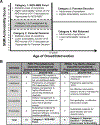An Age-Based Framework for Evaluating Genome-Scale Sequencing Results in Newborn Screening
- PMID: 30851990
- PMCID: PMC6535354
- DOI: 10.1016/j.jpeds.2018.12.027
An Age-Based Framework for Evaluating Genome-Scale Sequencing Results in Newborn Screening
Abstract
Objective: To assess the performance of a standardized, age-based metric for scoring clinical actionability to evaluate conditions for inclusion in newborn screening and compare it with the results from other contemporary methods.
Study design: The North Carolina Newborn Exome Sequencing for Universal Screening study developed an age-based, semiquantitative metric to assess the clinical actionability of gene-disease pairs and classify them with respect to age of onset or timing of interventions. This categorization was compared with the gold standard Recommended Uniform Screening Panel and other methods to evaluate gene-disease pairs for newborn genomic sequencing.
Results: We assessed 822 gene-disease pairs, enriched for pediatric onset of disease and suspected actionability. Of these, 466 were classified as having childhood onset and high actionability, analogous to conditions selected for the Recommended Uniform Screening Panel core panel. Another 245 were classified as having childhood onset and low to no actionability, 25 were classified as having adult onset and high actionability, 19 were classified as having adult onset and low to no actionability, and 67 were excluded due to controversial evidence and/or prenatal onset.
Conclusions: This study describes a novel method to facilitate decisions about the potential use of genomic sequencing for newborn screening. These categories may assist parents and physicians in making informed decisions about the disclosure of results from voluntary genomic sequencing in children.
Keywords: ASQM; NC NEXUS; NGS-NBS; NSIGHT; actionability; decision-making; disclosure; genetics.
Copyright © 2019 Elsevier Inc. All rights reserved.
Figures



Comment in
-
Large Scale Next Generation Sequencing and Newborn Screening: Are We Ready?J Pediatr. 2019 Jun;209:9-10. doi: 10.1016/j.jpeds.2019.01.037. Epub 2019 Feb 25. J Pediatr. 2019. PMID: 30819502 No abstract available.
Similar articles
-
Evaluating parents' decisions about next-generation sequencing for their child in the NC NEXUS (North Carolina Newborn Exome Sequencing for Universal Screening) study: a randomized controlled trial protocol.Trials. 2018 Jun 28;19(1):344. doi: 10.1186/s13063-018-2686-4. Trials. 2018. PMID: 29950170 Free PMC article.
-
A systematic framework for selecting gene-condition pairs for inclusion in newborn sequencing panels: Early Check implementation.Genet Med. 2024 Dec;26(12):101290. doi: 10.1016/j.gim.2024.101290. Epub 2024 Oct 5. Genet Med. 2024. PMID: 39375994
-
Genomic Sequencing for Newborn Screening: Results of the NC NEXUS Project.Am J Hum Genet. 2020 Oct 1;107(4):596-611. doi: 10.1016/j.ajhg.2020.08.001. Epub 2020 Aug 26. Am J Hum Genet. 2020. PMID: 32853555 Free PMC article.
-
Universal newborn screening using genome sequencing: early experience from the GUARDIAN study.Pediatr Res. 2025 Mar;97(4):1315-1319. doi: 10.1038/s41390-024-03647-w. Epub 2024 Oct 26. Pediatr Res. 2025. PMID: 39455856 Review.
-
The Reproductive Journey in the Genomic Era: From Preconception to Childhood.Genes (Basel). 2020 Dec 19;11(12):1521. doi: 10.3390/genes11121521. Genes (Basel). 2020. PMID: 33352697 Free PMC article. Review.
Cited by
-
Age-Based Genomic Screening during Childhood: Ethical and Practical Considerations in Public Health Genomics Implementation.Int J Neonatal Screen. 2023 Jun 27;9(3):36. doi: 10.3390/ijns9030036. Int J Neonatal Screen. 2023. PMID: 37489489 Free PMC article.
-
Parental Guidance Suggested: Engaging Parents as Partners in Research Studies of Genomic Screening for a Pediatric Population.Front Genet. 2022 Mar 25;13:867030. doi: 10.3389/fgene.2022.867030. eCollection 2022. Front Genet. 2022. PMID: 35401676 Free PMC article.
-
Combinatorial batching of DNA for ultralow-cost detection of pathogenic variants.Genome Med. 2023 Mar 14;15(1):17. doi: 10.1186/s13073-023-01167-6. Genome Med. 2023. PMID: 36918911 Free PMC article.
-
Perspectives of Rare Disease Experts on Newborn Genome Sequencing.JAMA Netw Open. 2023 May 1;6(5):e2312231. doi: 10.1001/jamanetworkopen.2023.12231. JAMA Netw Open. 2023. PMID: 37155167 Free PMC article.
-
Principles of Genomic Newborn Screening Programs: A Systematic Review.JAMA Netw Open. 2021 Jul 1;4(7):e2114336. doi: 10.1001/jamanetworkopen.2021.14336. JAMA Netw Open. 2021. PMID: 34283230 Free PMC article.
References
-
- Newborn screening: A blueprint for the future executive summary: newborn screening task force report. Pediatrics. 2000;106:386–388. - PubMed
-
- American College of Medical Genetics Newborn Screening Expert Group. Newborn screening: toward a uniform screening panel and system-executive summary. Pediatrics. 2006;117:S296–307. - PubMed
-
- Wilcken B, Wiley V, Hammond J, Carpenter K. Screening newborns for inborn errors of metabolism by tandem mass spectrometry. N Engl J Med. 2003;348:2304–2312. - PubMed
Publication types
MeSH terms
Grants and funding
LinkOut - more resources
Full Text Sources
Medical
Molecular Biology Databases
Research Materials
Miscellaneous

